論説

概要
- Many companies in the Netherlands are making ESG a cornerstone of their strategies to gain a competitive advantage.
- The environment is the current focus, but factors like the war for talent are crucial to broader ESG adoption.
- In exclusive interviews, C-level executives from 30 companies share their ESG challenges and how they’re overcoming them.
- ESG is seen as a significant value creation opportunity, both to grow the core business and enter new markets.
Companies across the Netherlands believe that rethinking business models and strategies to incorporate good environmental, social, and corporate governance (ESG) principles is causing their organizations to experience the biggest disruption in decades.
While this trend is exacerbated by external pressures, including regulation and rising consumer awareness, many companies are seizing the opportunity to set goals beyond what’s being demanded. They believe that doing so will give them a competitive advantage and keep them relevant in the long term, and are making sustainability a cornerstone of their strategy. This is also in response to most predicting that the intensity and speed of disruption will increase significantly. As Hans van den Berg, CEO at industrials group Tata Steel Netherlands, said: “We will have to adapt more in the next 8 years than we have had to over the past 100.”
The picture that emerges is of businesses at an inflection point. They feel compelled to respond to climate change and other ESG imperatives to maintain and grow their businesses, and to differentiate themselves in the war for talent. As a result, ESG is a top-three strategic priority for two-thirds of the leaders we spoke to (see Figure 1), who all have a global or regional headquarters in the Netherlands.
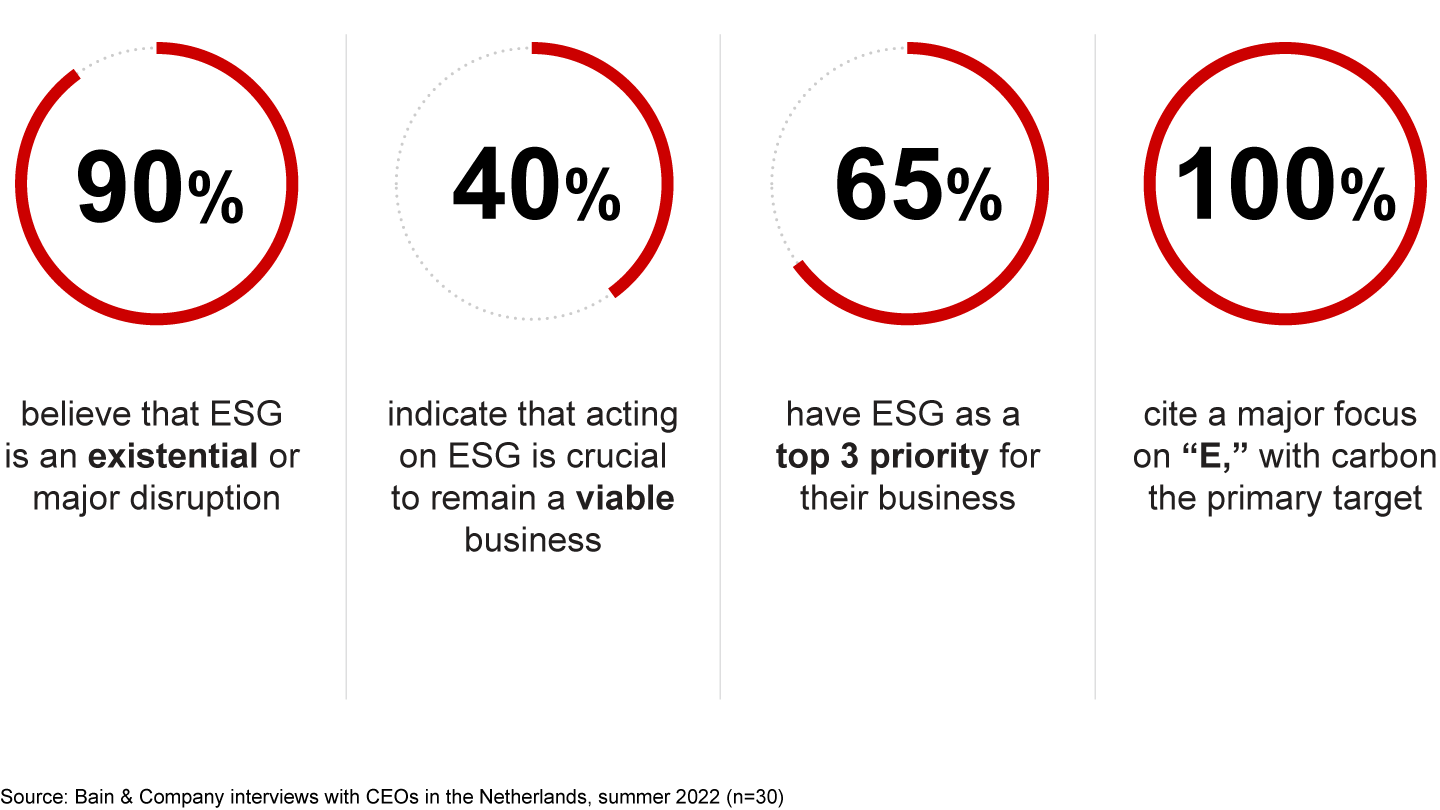
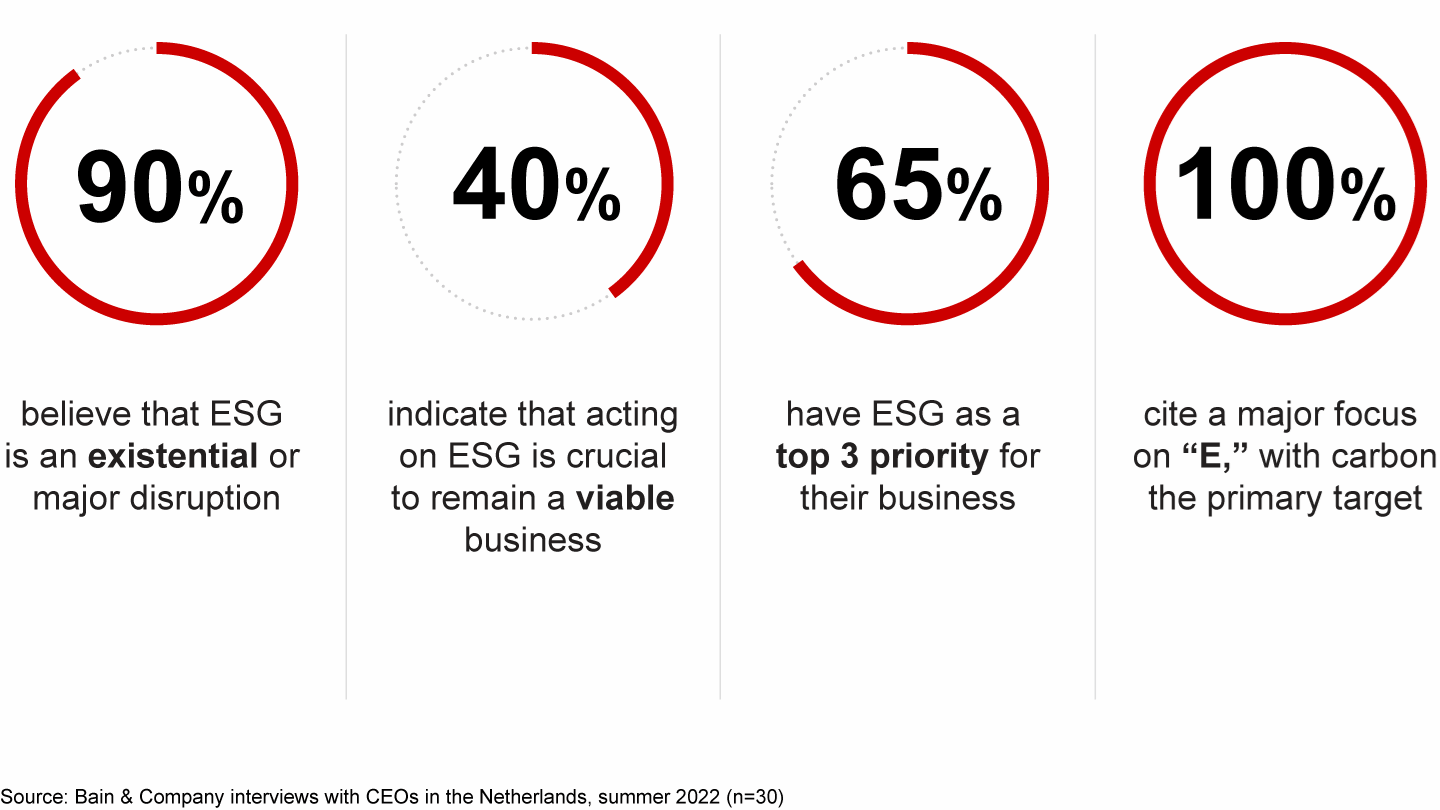
Like two sides of the same coin, they see failure to act as an existential threat, and taking action a significant opportunity. Sixty percent see acting on ESG principles as a driver of core growth, while two in five see them as a way to enter new markets. Those at the forefront of change say they’ll push ahead, even when they don’t have a clear-cut business case backed up by cost-benefit analysis. For these leaders, purpose is their driving force.
But ultimately in business, investment has to deliver a long-term payback. Acknowledging this, the CEOs shared how they capture progress and growth when embarking on an ESG-led transformation, as well as the challenges holding them back from doing more.
Indeed, with the Dutch CEOs giving themselves an average score of 6 on a scale of 10 for progress to date, there’s clearly more to be done. Just as they share how they capture value, they also share their tips for embedding ESG criteria to make transformation easier. Most, for example, readily accept that they’ll never have 20/20 vision for the future, but that as leaders they’re compelled to take calculated risks, move fast, and build partnerships—even with competitors—to create an ecosystem that benefits all.
Adapt to survive
ESG principles are no longer a nice-to-have—they’re a must-have if a company is to continue to exist and do business over the long term. But adopting and incorporating these principles is significantly shaking up the status quo. Companies are striving to find new, more sustainable ways to operate, grow, and attract the best staff, with purpose coming to the fore.
“ESG is very much existential—it’s survivability, not sustainability.”
While 90% of our CEOs said they believe that failure to respond to the forces behind ESG presents a threat, 40% volunteered that responding to ESG pressures was crucial to remaining a viable business. These CEOs are focused on the opportunity presented by new business streams and more efficient processes.
The importance of ESG to company futures is prompting decisive action in the boardroom. Under the broader ESG umbrella, all the CEOs we spoke to cite the environment as their No. 1 concern, with carbon reduction serving as the proxy for broader issues. There is, however, evidence that this focus is widening to include social and governance issues such as diversity, a fair living wage, transparency, and health.
In fact, half mentioned “purpose” as a motivator (see Figure 2). As Adriaan Thierry, CEO at consumer products company Bugaboo, said: “It starts with purpose—our purpose explicitly talks about current and future generations; half the words in our purpose are directly and indirectly linked to ESG.”
Frits Eulderink, COO of tank storage company Royal Vopak, said: “Our primary motivation is the responsibility we feel as part of society. If you don’t have a thriving society, you cannot have a thriving business.”
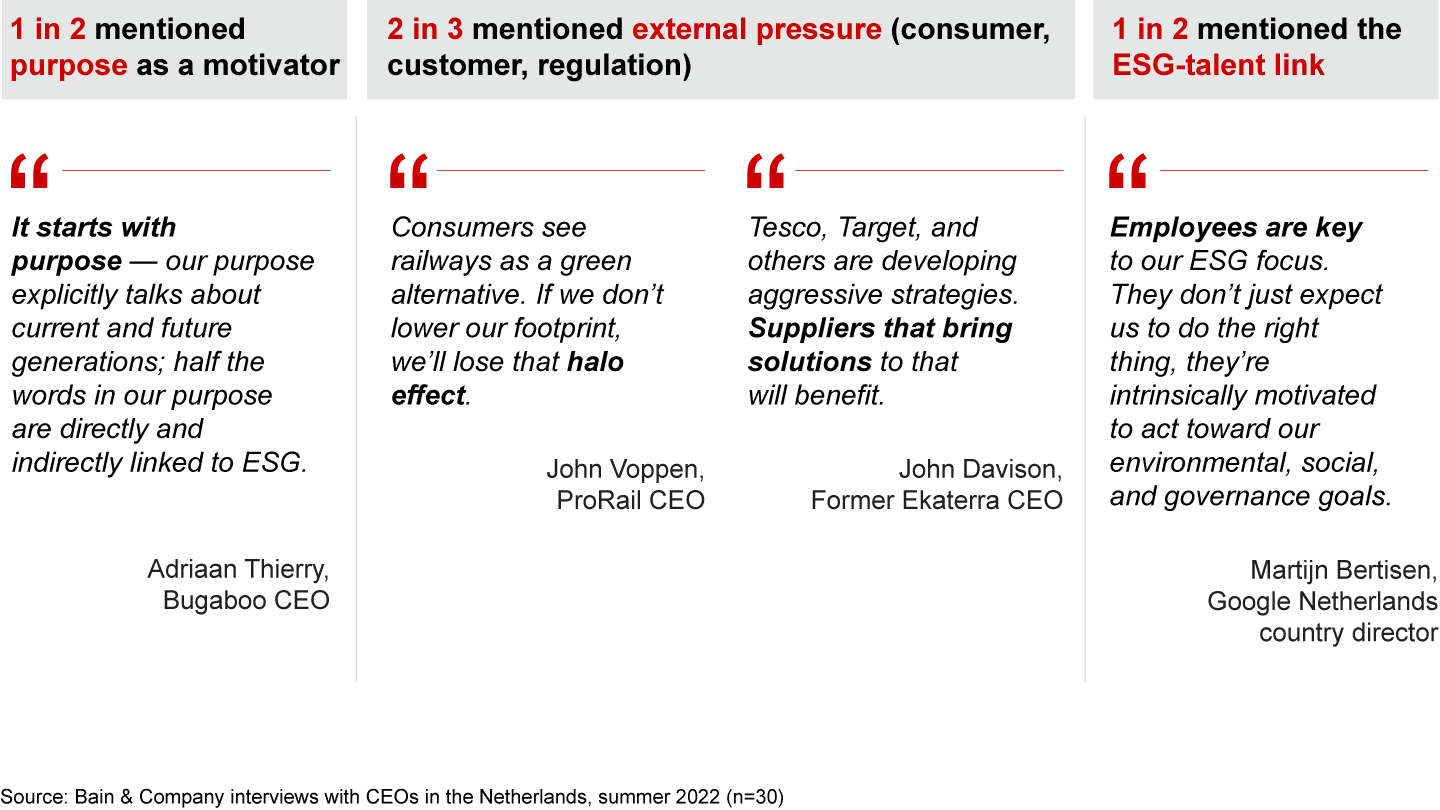
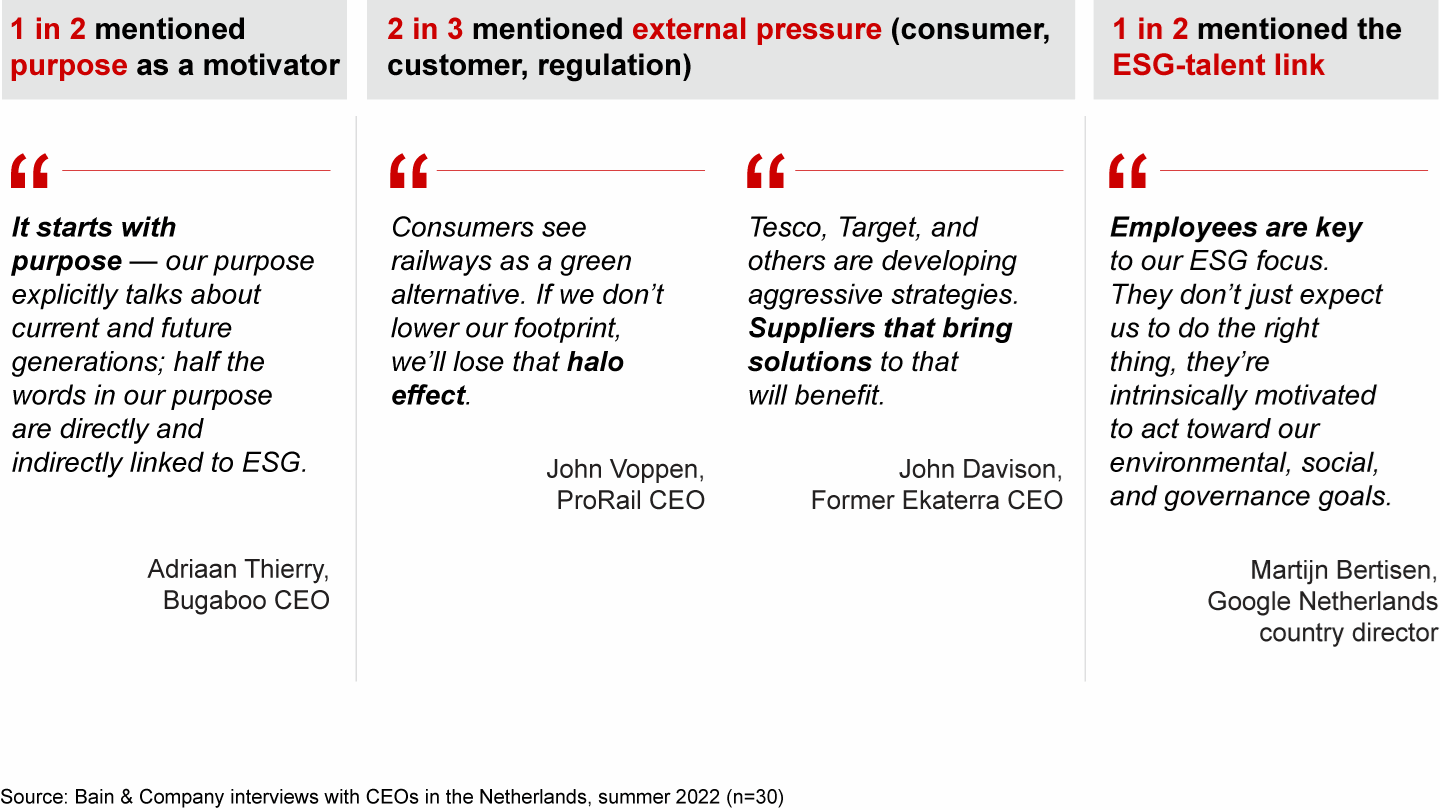
External pressures are, unsurprisingly, also seen as a key reason for action. Two out of three mentioned pressure from consumers, customers, and regulators. These companies firmly believe that their future operating ability rests on incorporating sustainable practices into their business models. They might be feeling direct consumer pressure to reduce the company’s carbon footprint, or even competitive pressures to come up with innovative solutions across the value chain.
“Tesco, Target, and others are developing aggressive strategies. Suppliers that bring solutions to that will benefit,” explained John Davison, former CEO of Ekaterra, the global tea business that recently split from Unilever.
Barbara van Koppen, SVP, corporate center, of airline KLM Royal Dutch, said: “We want to let future generations be able to embrace the wonders of the world, but we have a responsibility to do it sustainably.”
There’s also the threat of losing an existing or inherent advantage, either from failure to innovate or to new competitors. John Voppen, CEO at infrastructure services provider ProRail, acknowledged that public transport was seen as green, but added: “If we don’t lower our footprint, we’ll lose that halo effect.”
Our conversations made it clear that purpose and the influence of consumers, customers, and regulators are only part of the story. Increasingly, a company’s ability to recruit and retain staff can be directly tied to its reputation on ESG matters.
With younger generations prepared to vote not just with their wallets, but also with their time, companies are being held to account on ESG. Half of those we spoke to said there was a direct link between recruitment and their ESG policies.
“Employees are key to our ESG focus. They don’t just expect us to do the right thing, they’re intrinsically motivated to act toward our environmental, social, and governance goals,” said Martijn Bertisen, Google Netherlands country director.
In this way, ESG helps create a virtuous circle, attracting prospective employees, accelerating growth, and bringing in new revenue streams.
As Arthur van Benthem, CEO at Dunlop, said: “Sustainability is simply good business. It helps create energy with our people and supports our business objectives.”
Significant opportunities
While all the CEOs said tackling ESG is a must-do to preserve and enhance their core business model, two in five also plan to use ESG to power new business growth. One way to create an “Engine 2” is to reinvent the core with sustainability in mind (see Figure 3). These CEOs are finding ways to ensure that long-term ESG investments receive board approval and the necessary budget despite short-term pressures and existing commitments. They’re thinking “future-back” to reinvent business models for a more sustainability-focused world 10-plus years from now.
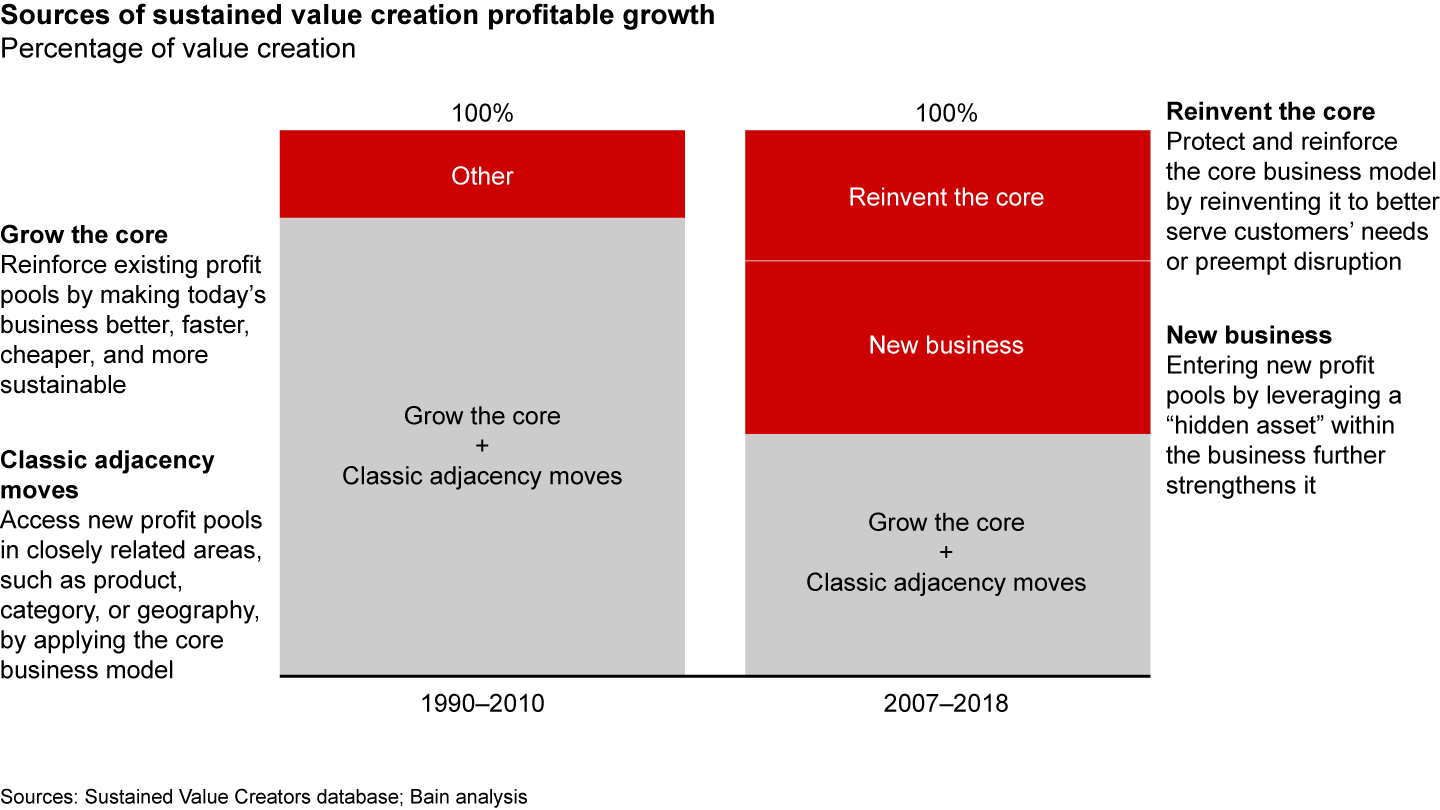
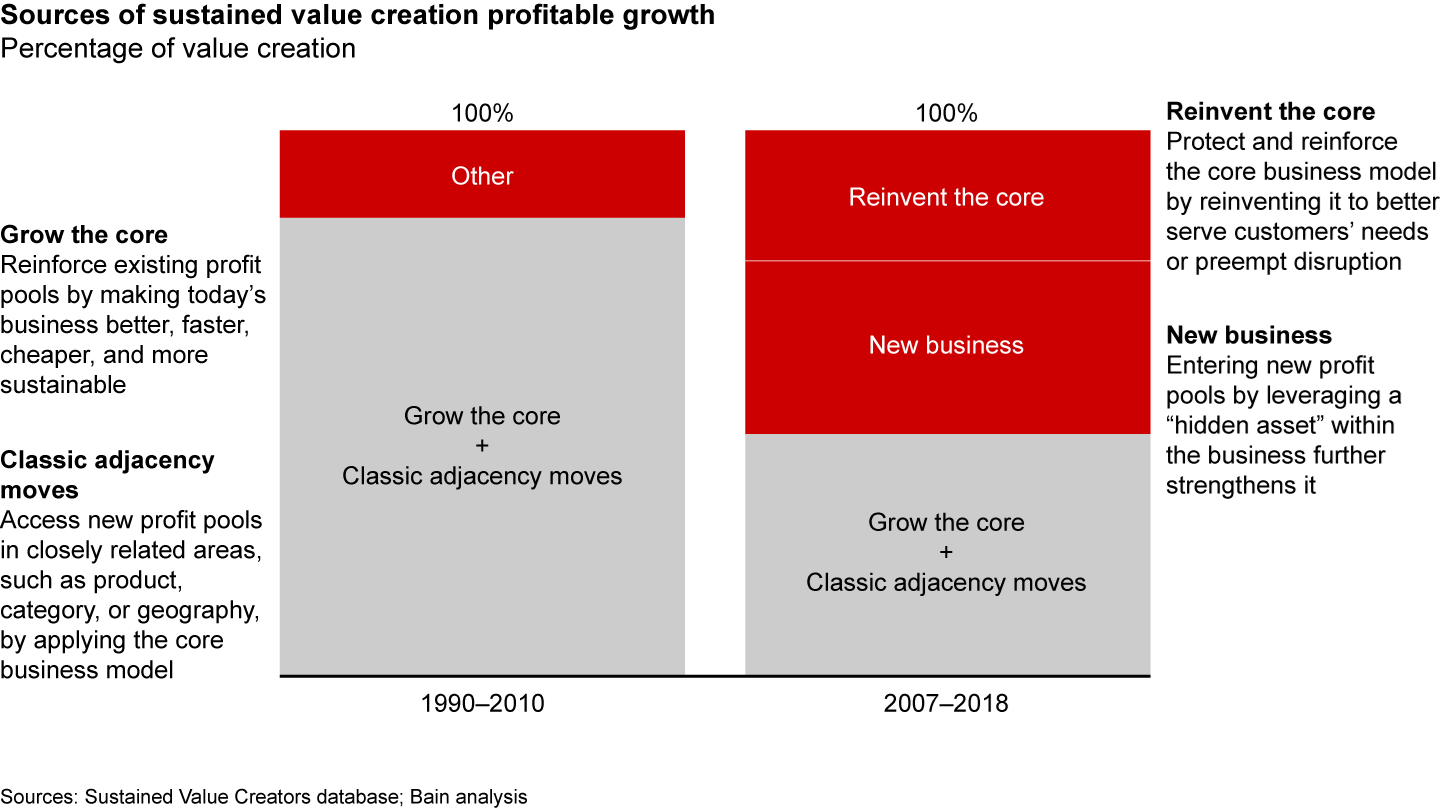
Those who see it primarily as an opportunity for transforming existing business are reviewing current practices so they can better serve customers’ needs and preempt disruption caused by new regulation and changing patterns of demand. Sixty percent of CEOs said their goal is to make the existing business more resilient and add a premium element to their proposition.
For example, Dimitri de Vreeze, co-CEO of life sciences company DSM, said: “We’ve achieved above-target growth by substituting nonsustainable products with sustainable alternatives such as plant-based ingredients, reduced-carbon dairy, and immune-boosting ingredients during Covid. It works.”
Those who are purpose-led see ESG as a way to reinvent their core, enter new businesses, and capture new markets. They appear to be following one of two routes.
The first is to help customers meet their own ESG goals. For the Port of Rotterdam, this has meant beginning construction of a hydrogen hub for customers seeking to reduce their carbon footprint. Once operational, this new hub will allow the port to create new value chains that are relevant to a low-carbon economy, attracting businesses with a sustainable focus. Financial services group ING is developing net-zero “climate pathways” for sectors it lends to, investing in low-carbon technologies and using its financing and advisory services to help clients transform their business models and operations.
The second route is to find a circular, future-proof business model and apply it to today’s market. Industrial bootmaker Dunlop embeds ESG in its commercial plans and roadmaps, collaborating with start-ups and other third parties that may be smaller and more nimble or just more specialized. One of Dunlop’s ESG projects involves “smart” boots with sensors and connectivity that increase productivity and prevent slip and trip accidents, currently one of the biggest causes of workplace accidents in industrialized countries.
“North-Western Europe is seeing little or no underlying growth . . . ESG could be a source of huge growth in a market that doesn’t grow.”
Which route a company takes will depend on its current business and how “at risk” it is from external pressures. For example, Olam is a global agrifood business that saw itself at high risk from disruption. Simply evolving wouldn’t position the company for future success. Instead, it developed AtSource, a platform for social and environmental sustainability insights and impact for agricultural supply chains. The company hopes full transparency and traceability of its products will boost growth.
ProRail, on the other hand, is already providing a sustainable transport service: trains. Even so, the company is investing in new ways to lower its carbon footprint and make rail travel more attractive to customers, such as switching to solar energy.
Leaders in ESG make investment nonnegotiable, protecting ESG investments and avoiding competition with other short-term commercial projects that have a clearer return on investment.
Dolf van den Brink, CEO of Heineken, said: “Of our total capex, a meaningful percentage is ring-fenced for ESG projects. It’s just like safety in the past—something we need to invest in to get right.”
Carl Grebert, vice president/general manager EMEA at Nike, said: “If you’re a product designer, you have the tools and information to best consider the footprint of every shoe you design. This prompts innovation and helps focus attention on making better products.” He added: “It starts with asking questions. As an employee, you are best placed to see what could be better or different.”
Capturing progress
Even when the board doesn’t expect an immediate return on ESG investments or innovations, it will still want to ensure that progress is effective and efficient. And it will want to try to measure that progress. This means quantifying the value of ESG wherever possible—a tough task made harder by a lack of universal metrics.
“ESG encompasses a broad and constantly widening range of topics, with no real consensus on the definition and scope of the terms,” said Steven van Rijswijk, CEO of ING.
CEOs leading the ESG charge use three tactics to help them do this. The first is to identify and communicate to stakeholders how ESG plays into their overall corporate strategy. It starts by identifying the company’s “bass notes”—topics such as waste reduction, diversity, health and safety—which are important to stakeholders and must therefore be addressed, but are to some degree already table stakes.
In tandem with this comes identifying and communicating the “high notes”—areas where the company wants to establish clear water between it and competitors, (see Figure 4). These will be attributes and activities that make the company distinctive and allow it to engage with its stakeholders. For example, Hellmann’s, part of consumer goods group Unilever, focuses on avoiding food waste. It doesn’t always require a change to the physical product, but it does require influencing consumer behavior. Behavior change is key.
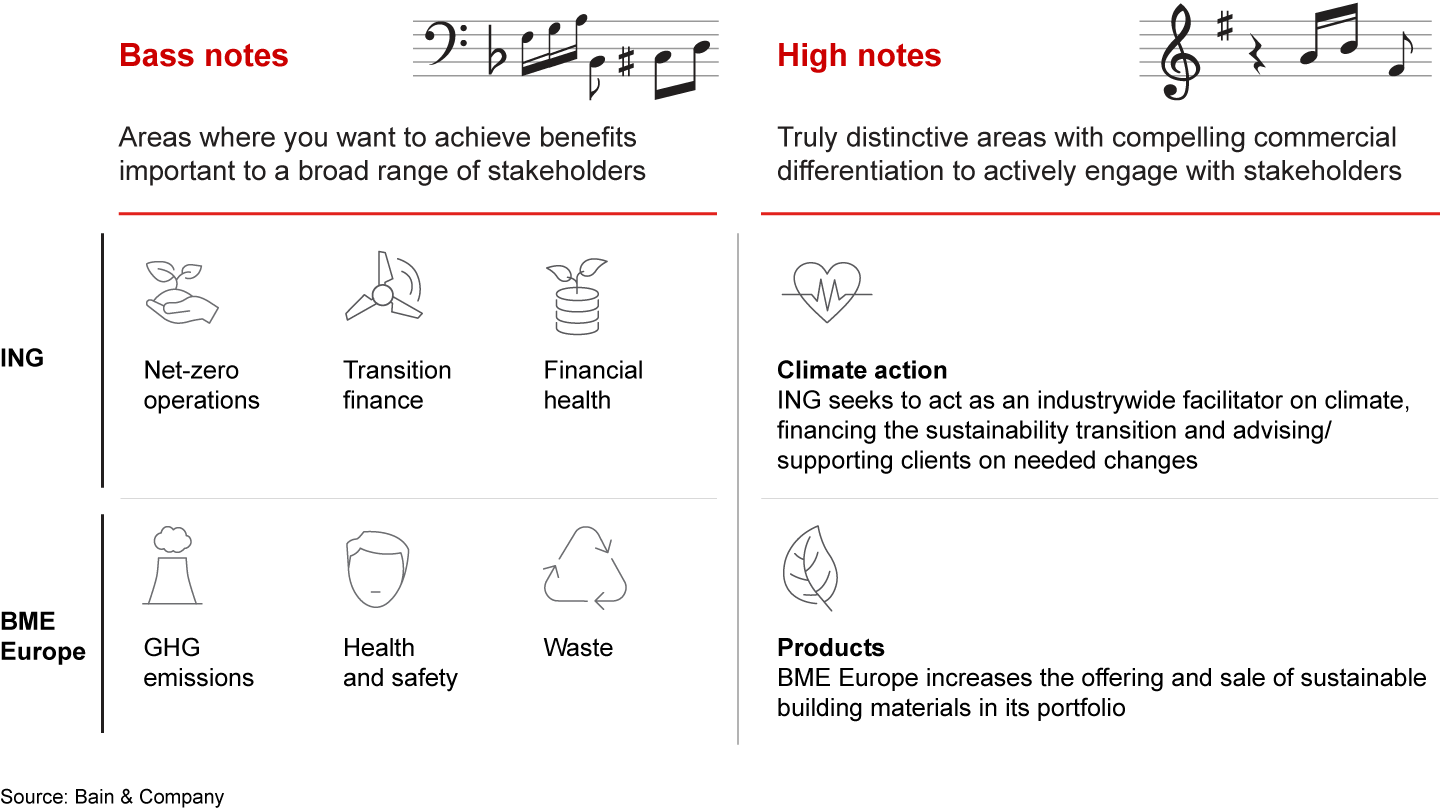
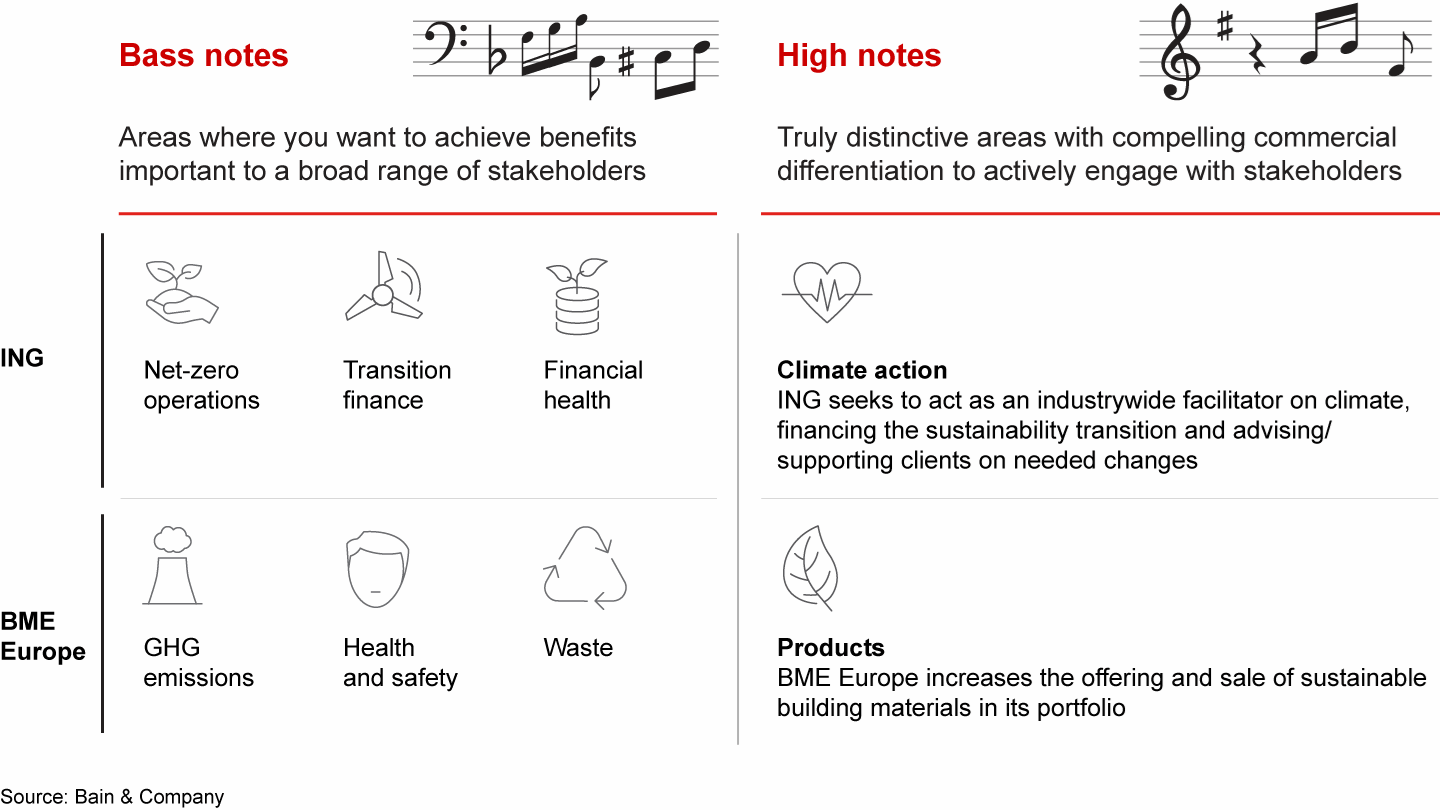
The second tactic is to get employees on board, unleashing their knowledge, passion, and innovation. Key is ensuring that middle managers are given an incentive to take up these ideas so they too can deliver on sustainability as well as profit. When staffers feel confident that ESG is embedded in the culture and decision-making processes, they’ll bring new ideas to the table, helping the company innovate and create value.
Nike encourages staff to find ways to reduce waste, and a team in its distribution center saw an opportunity evaluating the condition of returned shoes in-house. Previously, a smaller subsection of returns would be graded unsaleable, and then turned into recycled Nike Grind materials. However, under this plan, a majority of that volume could actually be quality assessed as “return to stock,” or—with cleaning or retagging—sold as “almost new” in a newly rolled out “Nike refurbished” program in select Nike outlet stores.
The third tactic is giving middle managers supportive frameworks to add ESG to their day-to-day decisions and performance goals. This could mean applying internal carbon pricing, offering sustainability calculators showcasing the effects of different options, and reporting key ESG metrics along with financials. The broad aim is to encourage them to make bold decisions with ESG at their core.
“To prioritize ESG initiatives, we back-calculated the budget needed to reach our 2025 targets. The key is to pick a few priorities and KPIs where you really want to see a difference. These initiatives are therefore protected in the decision-making process.”
To this end, one executive set ESG on an equal footing with growth, profitability, and capital returns. The company developed an incentive scheme around three quantifiable ESG metrics to encourage intended behavior. Another provided a scorecard for procurement to measure ESG and allowed a 10% higher cost for top-scoring suppliers.
Transformation: Could do better
Most CEOs acknowledge that there’s plenty more to do. Just 10% of those we spoke to scored themselves a 9 or 10 for their ESG transformations to date, with an average score of 6 on a scale of 10 (see Figure 5).
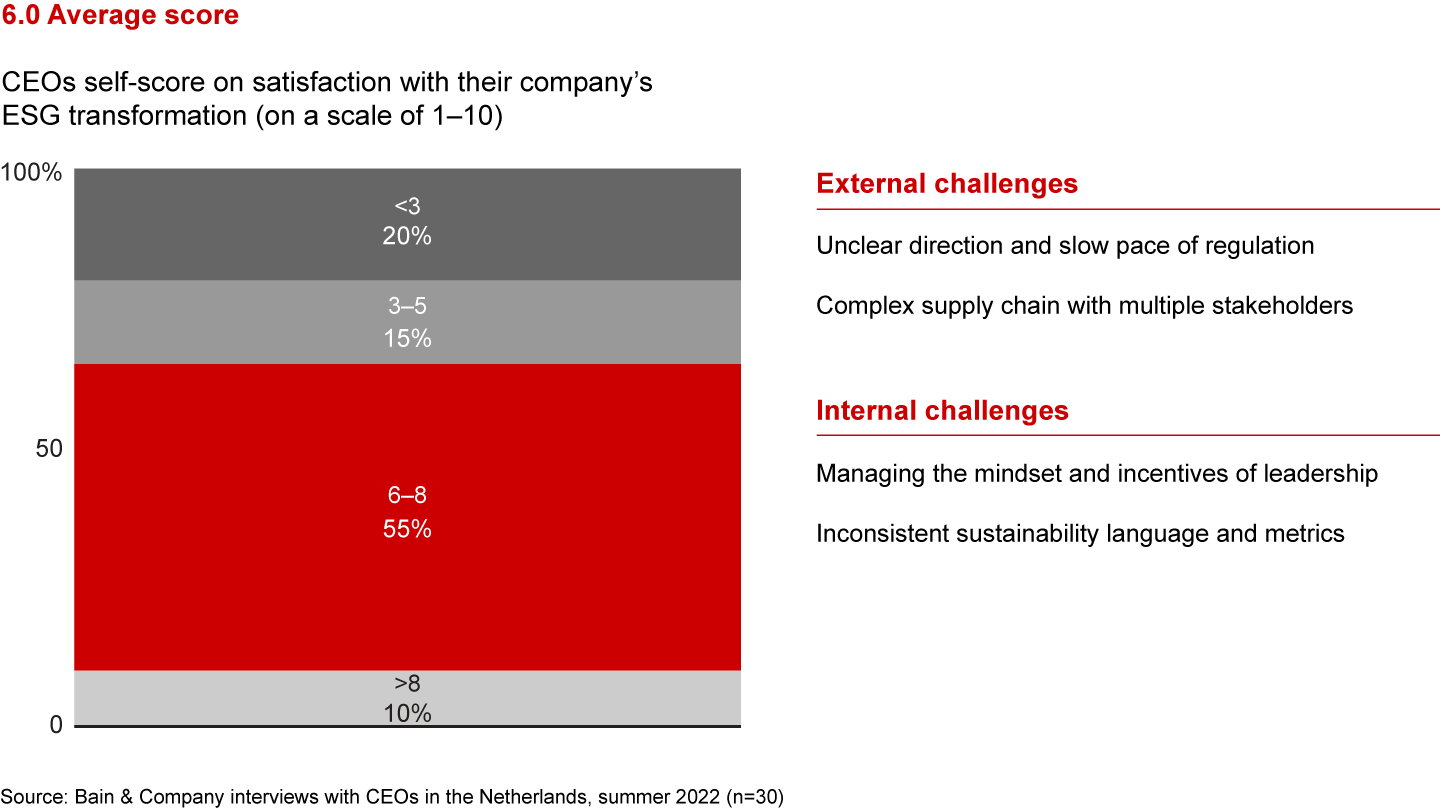
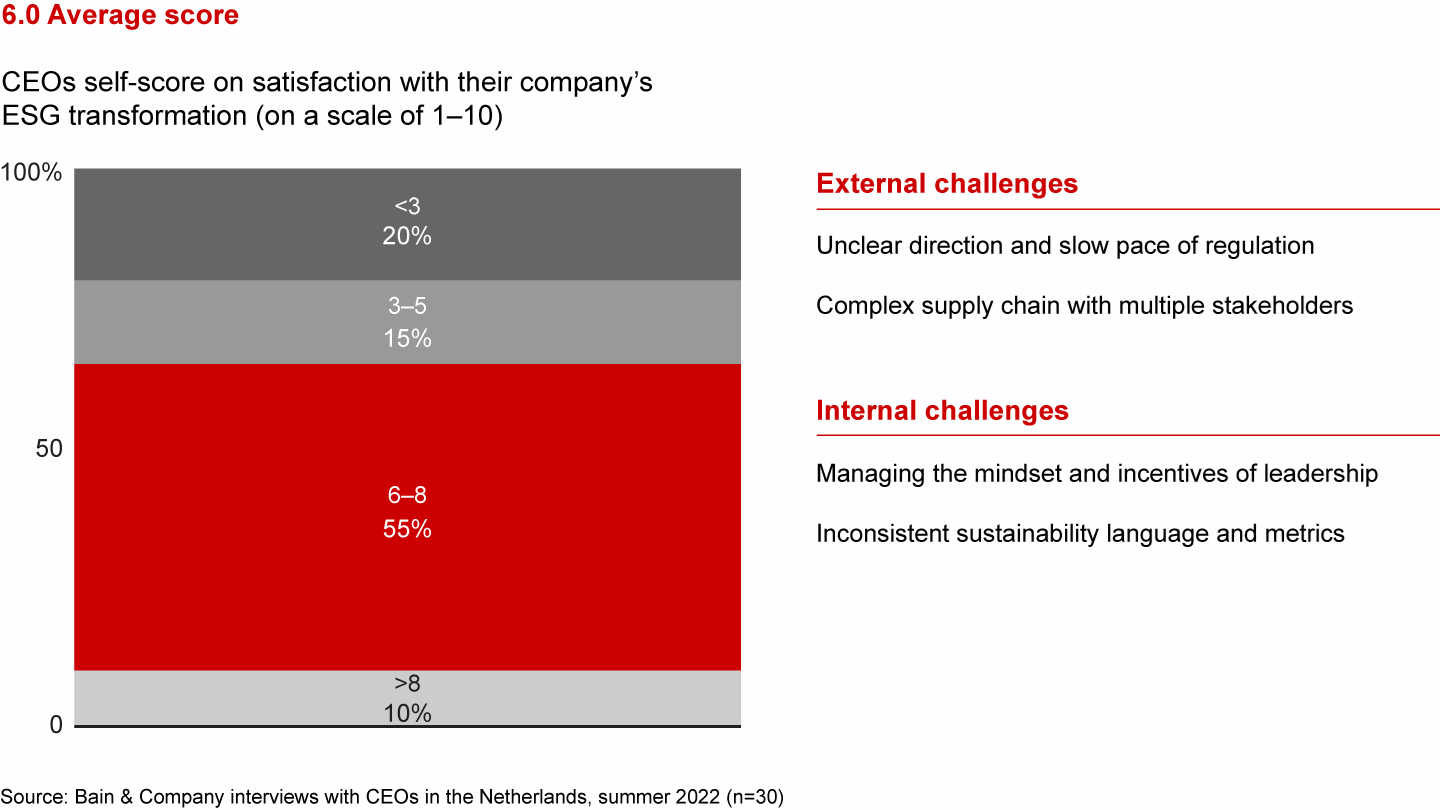
Those scoring 8 or lower voiced frustration at the challenges they face, both internal and external.
For the latter, they cited regulation. Here, the main challenges were the unclear direction regulation may take and its slow pace.
“We need to make our thinking and acting around sustainability less academic, less perfectionistic, and more pragmatic . . . We need to make decisions and go with them.”
But the CEOs also cited complex and multistakeholder supply chains as an external challenge. Given that no single company has all the solutions, ESG issues cannot be solved exclusively within a company’s four walls. Ensuring that all parties are pulling in the same direction and at the same speed is proving challenging. Meanwhile, managing company leaders’ mindsets, as well as aligning incentives with ESG-positive changes against a backdrop of imperfect sustainability metrics, were seen as internal barriers to doing more.
As a result, frustration is accompanied by disappointment at progress to date.
Manfred Aben, VP at Unilever Netherlands, said: “Our greatest challenge is that we don’t have all the solutions; we need to work in true partnership with others. We talk to animal feed companies, for example, on microbiome in the soil. They are a player in the broader puzzle. The issues are very complex across the total value chain.”
Winning strategies and top tips
Our study gives an up-to-date, in-depth picture of where Dutch companies feel they are with ESG. It shows everyone is moving toward a more sustainable way of doing business, but that most have significant work to do.
“If you want sustainability, you need people all across the organization to share and live by these values. This collective dynamic is the key to success.”
Below is what works for CEOs who are placing sustainability at the core of their business strategies:
- Embed ESG across every element of the business
ING has made sustainability one of its two key strategic priorities, updating its governance accordingly and giving all management board members ESG-related KPIs that cascade through the various business lines and functions. - Pick your battles
Don’t try to do everything at once. Prioritize and pick a few of the most important KPIs to act on and measure. - Encourage strategic ESG thinking
It’s also about linking these ESG-based KPIs to long-term incentives. At Heineken’s 2022 annual general meeting, the company added ESG metrics as part of its long-term incentive compensation for all LTI-eligible employees globally. - Communicate
To ensure KPIs and the broader ESG goals are clearly understood, communication and ownership are a must. “ESG should be owned by everyone,” advised Richard Kooloos, director of group sustainability at financial services group ABN Amro.
When values are shared, everyone pulls in the same direction. According to Nike’s Grebert, this happened when the group embedded consumer, business, and environmental thinking into its decision making. “It’s transformational. It’s becoming a common language for our teams and encourages many more employees to come up with ideas.” - Pragmatism wins the day
Efforts will fail without long-term thinking. Essentially, much of our CEOs’ advice comes down to pragmatism about long-term goals.
“If a company wants to be a leader, it cannot think only about the short-term costs associated with sustainability. It must also think about the long-term benefits and value creation,” insisted Remco Teulings, CEO at industrials group BME Europe.
This means accepting trial and error. - No time like the present
Our ESG executives believe it’s vital to move fast and dive in.
“With ESG, it’s about taking the long-term view and being ready to go beyond the pure business rationale,” said Signify’s Rondolat. One company simply removed parking places. “If you make it less attractive, people will end up taking the train or cycle,” said Allard Castelein, president and CEO at the Port of Rotterdam. - Partner for success and dilute risk
Companies leading on ESG have worked hard to find like-minded partners. Collaboration is key, whether it’s working along a company’s own value chain or with competitors in areas that can benefit from improved ESG practices.
“You must work with your key competitors in one of your key technologies, which is unusual. We can’t do this alone.”
“I’m a strong believer in forming coalitions of the willing—of encouraging CEOs to look for partners who add competencies, skill sets, or financing,” said the Port of Rotterdam’s Castelein, while Coca-Cola’s country director, Karlijn in ‘t Veld said: “Collaborating with industry partners, governments, and NGOs means we can share our dilemmas and try to solve them together.” - Finally: Enjoy the ride
Essentially, it comes down to getting on with it. “It’s difficult and hard to change. But be joyfully persistent. Never let go,” advised ABN Amro’s Kooloos, while Vopak’s Eulderink said: “I feel tremendously lucky that I am alive in this period. This is our chance to make a difference.”
This report has been created in partnership with the American Chamber of Commerce in the Netherlands.